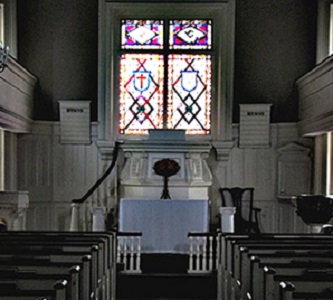
Courtesy of Walking Philly, Flickr's Creative Commons
On 11 different voyages between 1638 and 1656, the ships Fogel Grip and Kalmaar Nyckelcarried Swedish colonists to the New World. Today, visitors to Gloria Dei National Historic Site can see models of these ships suspended from the ceiling. Like many other European colonists, Swedish colonists made the voyage to the New World seeking business opportunities. The early Swedish colonists settled in the area around Wilmington, Delaware, while a later group of Swedish colonists established a settlement under Swedish governor John Printz in the area that would become Philadelphia in 1642. Since most of the Swedish colonists were Christians, they brought with them a pastor and began to found congregations around the Delaware Valley in Pennsylvania.
In the late 1600s, landowner Sven Svenson donated a site for the Swedish colonists to build a permanent place to worship. American Indians knew the land and future site of the Gloria Dei Church as Wicaco, which means a “peaceful place.” In 1677, the colonists converted an existing log blockhouse on the site into the first church. By the late 1690s, the colonists decided that they needed a more permanent place to worship. The congregation began building the Gloria Dei Church in 1698. The dedication of the church took place on July 2, 1700. The church continued to thrive in William Penn’s colony with its legal guarantee of religious tolerance.
 |
|
A wood carving of two cherubs with a Bible. It was brought from Sweden before 1646
Courtesy of James Mundie, Flickr's Creative Commons |
By 1704, the church’s tower was complete, and the congregation added a sacristy and a vestibule to the north and south sections of the building to give the church a cruciform footprint and to provide additional support to the walls and the roof. Architecturally and stylistically, the church exhibits medieval, Gothic, and Georgian influences. The symmetrical lines of the church, with its decorative shapes, steep sloped roof, and narrow tower reflect a blending of building styles and methods. While Swedish colonists directed the construction of the church, they did not insist on building a church using only Swedish traditions. Instead, they hired Philadelphia builders who had training in the English craft guild tradition. This is a reminder that at the time of the church’s construction, the New World was quickly becoming a place where different cultures and cultural practices greatly influenced one another.
The congregation grew so much by the 1840s that church members made the decision to renovate the original building. During this renovation, they raised the floor and balconies, and added a center pulpit and a stained glass window. While the building underwent a restoration in 1999, the church remains relatively unchanged since the major renovation in 1846.
 |
|
Gloria Dei's single stained glass window
Courtesy of Walking Philly, Flickr's Creative Commons |
At Gloria Dei Church National Historic Site, visitors can visit the historic church building and view an array of historic artifacts. Key historical features include the Swedish baptismal font that was imported in 1731 and is one of the oldest fonts still used in the nation; a chandelier given to the church by famous artist, Carl Milles; a wood carving of two cherubs with a Bible that was brought from Sweden before 1646; and a wood carving of the angel Gabriel that is an exact replica of the 11th century original in Gothenberg, Sweden. The church also contains an organ purchased in 1902 from the Hook & Hastings firm of Boston. Gloria Dei may have been the first church in colonial America to use an organ, possibly as early as 1703.
Other historic features at Gloria Dei include its stained glass window, its steeple bell, an early lightning rod, and its historic burial grounds. Constructed in the mid-1800s for the 1846 renovation, Gloria Dei’s single stained glass window is one of the earliest examples of American stained glass. The bronze steeple bell was cast in 1806 from a bell (dated 1634) that was originally used at the log cabin church in Tinicum, a principal Swedish settlement in the Delaware Valley. Remnants of an early lightning rod are visible on the church’s exterior. This is likely due to the close friendship Nils Collin, the priest of the church from 1786-1831, had with Benjamin Franklin and his active place in Philadelphia’s intellectual circles.
The Gloria Dei cemetery has been in continuous use since the early 1700s and is one of the oldest burial grounds in Philadelphia. Buried throughout the cemetery are Swedish immigrants, sea captains, Revolutionary War soldiers, scientists, Civil War soldiers, artists, and ministers. Their tombstones and engravings provide a tangible link to early European settlers, the history of colonial America, and the creation of a new nation.
Designated a National Historic Site in 1942, the Gloria Dei (Old Swedes’) Church National Historic Site today stands in the middle of an urban environment. The church and historic cemetery are open to the public providing visitors a tangible link to the early Swedish settlers and an opportunity to explore over 300 years of history.
Gloria Dei Church National Historic Site, a unit of the National Park System, is located at 916 S. Swanson St., Philadelphia, PA. Gloria Dei is an active religious congregation and is home to the parish minister. The Historic Site is open from 9:00 am until 4:00 pm Tuesday-Sunday from September to May and daily from June to August. For more information, visit the National Park Service Gloria Dei Church National Historic Site website or call 215-389-1513. For information about church services, visit the Gloria Dei church's website or contact the Rector at (215) 389-1513.
Gloria Dei Church has been documented by the National Park Service’s Historic American Buildings Survey.
Last updated: August 11, 2017
